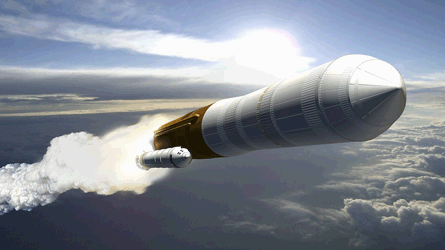Design contracts for NASA's Ares V cargo launch vehicle (CaLV) and its Altair lunar lander payload are to be awarded in the next few days and weeks.
Both are key to NASA's plan to go to the Moon from 2020, and at the Space Foundation's National Space Symposium in Colorado Springs from 30 March-2 April, Boeing, Lockheed Martin, Pratt & Whitney Rocketdyne and Northrop Grumman told Flight International about how they could be engineered.
"There is no great advantage of dry composite structures on the core [stage]," says Lockheed Space System's exploration systems vice-president Ronald Wetmore, referring to Ares V's second stage. Composites are thought to save weight and improve performance and Wetmore was referring to a NASA/industry study that preceded the Ares V bids. The rocket's super structure, without propellant tanks, is deemed to be dry. The tanks, because they hold fuel and oxidisers, are wet.
The study also investigated making the tanks composite, but as Boeing Exploration Launch Systems vice-president and Ares I upper stage production programme manager Jim Chilton says, that "could require more development time than we have".
 |
|---|
© NASANASA's Ares V cargo launch vehicle (CaLV) ascends into space |
| NASA is to place multi-million dollar design contracts with multiple companies in the next three months for its Ares V cargo launch vehicle and Altair lunar lander. The Ares V will launch the Altair for a return to the Moon in 2020. NASA had told industry that the Ares V design support contracts awards announcement would be in the first week of April, but work would not start until July. NASA created five work packages for Ares V design support. The packages follow the different elements of the vehicle: its shroud, or fairing; the Earth departure stage; the avionics; and the core and first stages. The first stage is two solid-rocket boosters. These work package awards are deemed phase one of a two-stage process and the second will be the awarding of the design, development, test and evaluation (DDT&E) contract to a single company in the first quarter of 2012. The DDT&E contract will see the rocket's development through to its deployment. Phase one is to have fixed-price contracts for each of the work packages. For the Earth departure stage and the core each contract is worth $20.5 million, the first-stage award is $13.7 million and for the avionics and the shroud, companies get $6.85 million each. In June NASA's Altair project office expects to place multiple awards for its conceptual design contract. According to a December 2008 pre-proposal conference presentation, multiple conceptual design contracts worth at least $42.2 million over four years are to be awarded. This year and 2010 will see "base awards" of $1.6 million and $5.6 million respectively. This work will see companies collaborate with the Altair project office on the lander's design. Then in 2011 and 2012 there are the two option awards. They are extensions of the original contract and option one is worth $15 million and two, $20 million. The Altair DDT&E contract is expected in 2013. |
The core and EDS are two of five work packages industry is bidding for. The other three are the shroud, avionics and the first stage, which comprises two 5.5 segment solid-rocket boosters. Wetmore says NASA wants to have two awardees for each, for a total of 10 awards.
But the core and EDS engines are not included. They are being developed with P&WR, which says only requirements have been discussed for the core stage's RS-68B engine. But the EDS J-2X engine is past its critical design review and it is to be used from 2015 for the Ares I crew launch vehicle.
For Ares V's electronics, Lockheed, which is developing the avionics for the Ares I payload, the Orion crew exploration vehicle, is arguing for common systems.
Lockheed might win the argument if some new ideas for Altair bear fruit. NASA is looking at cannibalising Altair's descent module for spare parts. Its avionics could be used for rovers and habitats. It is an option for NASA and the contractors that win its conceptual design contracts. Altair will take power and interact with the EDS and Orion during missions anyway.
While final decisions about cannibalising modules may stretch into the next decade, "by [June 2010] we will know pretty much what Altair will look like," says Northrop Grumman aerospace systems business development director Bob Davis.
Northrop expects three design contracts to be awarded by NASA and if it wins it knows it will start with the agency's latest concept, an 8.8m (28.8ft)-wide flatbed descent stage with a smaller ascent stage on top.
But nothing is ruled out and Davis knows that a side loading lander is possible, although its width means it has to be launched vertically on Ares V. Another radical design option is to have toroidal propellant tanks instead of cylindrical.
While it is early days for Altair and Ares V, in March NASA and a group of companies started a lunar systems risk reduction study, to examine Moon operations after the lander has landed. That should end in June and it will, Davis says, "influence Altair further down the road".
Source: Flight International


























